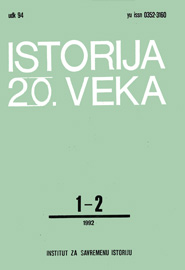SPORAZUM CVETKOVIĆ-MAČEK I PITANJE RAZGRANIČENJA U SREMU
THE CVETKOVIĆ-MAČEK AGREEMENT AND THE QUESTION OF BORDERS IN SREM
Author(s): Mira RadojevićSubject(s): Geography, Regional studies, Diplomatic history, Political history, Recent History (1900 till today), Interwar Period (1920 - 1939), Inter-Ethnic Relations, Geopolitics
Published by: Institut za savremenu istoriju, Beograd
Keywords: Serbia; Croatia; Srem; border question; Cvetković-Maček agreement; 1939; Banovina Hrvatska;
Summary/Abstract: The conflict between the Serbs and Croats over Srem is one of their earliest and most difficult disputes and is also part of the rich and often dramatic difficult history of this region. Srem had already become the »stumbling block between the two nations« at the time of the revolution of 1848-1849. The issue of ownership then raised over Srem has not been settled to this day, notwithstanding short periods of calm. In the dispute, Croats claimed to have rights in terms of state and history, resulting from state and historical arrangements and contracts made by the Hungarian state, by which Srem, while under Hungarian rule, had been one of the administrative areas of Croatian and Hungarian Slavonia. Defending the idea of a Serbian Srem «, the Serbs emphasized their ethnic and historical rights, founding these claims on several intense Serbian migrations to these parts, on their superiority in number resulting from these migrations, on their importance in halting the Turkish invasion of Central Europe, their connection with other Serbian regions and their role in the Serbian history and culture in general. The dispute was still unresolved at the time the August 1939 Cvetković-Maček Agreement was revived, by which two districts of Srem had been annexed to Banovina Hrvatska - the district of Sid and llok, along with the districts Vukovar, Vinkovci and Zupanja, which had been annexed to Banovina Hrvatska as parts of the form er Savska Banovina. The new banovina thus encompassed not only over half the territory of Srem but also districts in which Serbs were in the majority - Sid, llok and Vukovar. This solution and the announcement of the Croats that in the final reform of the Kingdom of Yugoslavia they would demand the whole of Srem, all the way to Zemun, provoked the discontent and anxiety of the Serbs, both of those who had been directly affected by the Agreement signed in August 1939 but also of all Serbian parties, scientists and the press. The beginning of the Second World War in Yugoslavia broke off this dispute but some of the provisions of the Agreement remained valid when the war ended. The districts of llok and Vukovar remained in the federal unit of Croatia, which recently again gave rise to hostility between the Serbs and Croats.
Journal: Istorija 20. veka
- Issue Year: 1992
- Issue No: 1+2
- Page Range: 61-72
- Page Count: 12
- Language: Serbian

